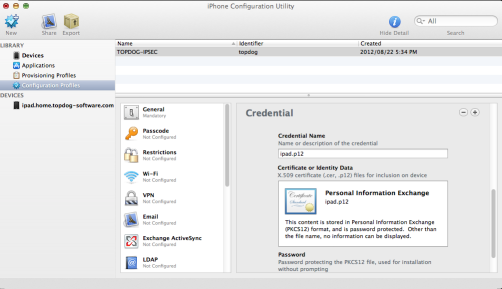IntroductionThis howto describes setting up an IPSEC VPN for use with the Iphone, Ipad and Mac OSX VPN clients on Centos/RHEL 6. I am using the 5.x branch of Strongswan which is now the mainline actively maintained branch. At the time of writing the 5.x EPEL package was only available in the testing repo. The configuration should work both with NAT and without NAT on both sides, if you are NATing on the server side make sure your forward UDP 500 and 4500 to the machine running strongswan. This howto uses example.org and 192.168.1.0/24 and 192.168.2.0/24 networks for illustration purposes, you need to change these to suit your own setup. InstallTo access the EPEL packages you need to enable the EPEL repo. You are then able to install the strongswan package.
Create the required configuration directories
ConfigurationCreate a CAFor RSA authentication you need to setup a CA which will issue the certificates to be used by the server and the clients.
Install to strongswan directories
Create the server certificateApple clients require that the servers certificate subjectAltName attribute contain either the server IP address or server DNS name. To ensure the server certificate contains the subjectAltName attribute edit the openssl.cnf and set it under the [ usr_cert ] section For DNS name set it to
subjectAltName=DNS:vpn.example.org
For IP address set it to
subjectAltName=IP:192.168.1.1
Now generate and sign the server certitifcate
Install to strongswan directories.
Add the private key password to /etc/strongswan/ipsec.secrets : RSA vpn.example.org.key "p4ssw0rd" Create the client certificateThis is the certificate that will be used by you VPN clients ie Ipad/Iphone, edit the openssl.cnf and comment out the subjectAltName attribute setting. Now generate and sign the client certificate, do this for all the clients you expect to use.
You now need to import the CA certificate and the client p12 certificate on to the device. You need to download the Iphone configuration utility and use it to import the certificates to your device.
Add the username and password to /etc/strongswan/ipsec.secrets andrew : XAUTH "5tr0ngp4ss0rd" Create strongswan configurationEdit /etc/strongswan/ipsec.conf with the following content. config setup conn %default ikelifetime=60m keylife=20m rekeymargin=3m keyingtries=1 keyexchange=ikev1 left=%defaultroute leftsubnet=192.168.1.0/24 auto=add conn rw-xauth leftcert=vpn.example.org.pem leftid=@vpn.example.org leftauth=pubkey leftfirewall=no right=%any rightauth=pubkey rightauth2=xauth rightsourceip=192.168.2.0/24 The above setup assumes the network behind the vpn is 192.168.1.0/24 and virtual IP addresses will be assigned to VPN clients from the 192.168.2.0/24 network block. Add iptables rulesEdit your /etc/sysconfig/iptables and add the following rules -A FORWARD -m state --state ESTABLISHED,RELATED -j ACCEPT -A FORWARD -m state --state NEW -s 192.168.2.0/24 -j ACCEPT -A FORWARD -m state --state NEW -s 192.168.1.0/24 -j ACCEPT Enable packet forwardingIf your system is not setup for packet forwarding enable it.
Edit /etc/sysctl.conf and set net.ipv4.ip_forward = 1 TestingStart strongswan.
Check /var/log/messages and /var/log/secure for any errors. Ipad configuration
Set the Fields
A VPN connection should now be possible by toggling VPN to ON under Settings > VPN . |

